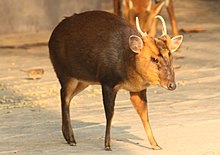Hairy-fronted muntjac
| hairy-fronted muntjac | |
|---|---|

| |
| Scientific classification | |
| Domain: | Eukaryota |
| Kingdom: | Animalia |
| Phylum: | Chordata |
| Class: | Mammalia |
| Order: | Artiodactyla |
| Family: | Cervidae |
| Subfamily: | Cervinae |
| Genus: | Muntiacus |
| Species: | M. crinifrons
|
| Binomial name | |
| Muntiacus crinifrons (Sclater, 1885)
| |
The hairy-fronted muntjac or black muntjac (Muntiacus crinifrons) is a type of deer currently found in Zhejiang, Anhui, Jiangxi and Fujian in southeastern China. It is considered to be endangered, possibly down to as few as 5–10,000 individuals spread over a wide area. Reports of hairy-fronted muntjacs from Burma result from considering the hairy-fronted muntjac and Gongshan muntjac as the same species. This suggestion is controversial.[1] It is similar in size to the common muntjac.
Hairy-fronted muntjacs are extremely difficult to study because of their shyness. Camera-trap photographs have revealed the presence of hairy-fronted muntjacs where they were believed not to have existed for decades, for example in the Wuyanling National Nature Reserve.[2]
This species was for a very long time one of the most poorly known deer in the world. It was also considered highly endangered; up to 1975, it was only known from a few museum specimens, at least to western scientists. The species has been heavily harvested throughout the 20th century and in 1978 at least 2,000 animals were killed. The current population in China was assessed in the early 1990s to be ca 10,000 animals however it has declined much since and the current population is likely to be well under 7,000.
See also
References
- ^ a b Template:IUCN2008 Database entry includes a brief justification of why this species is of vulnerable.
- ^ "珍稀动物频频首现乌岩岭 ("First sightings of rare animals often in Wuyanling")". Zhejiang Province Wuyanling National Nature Reserve. 2012. Archived from the original on 21 May 2013. Retrieved 24 March 2013.
{{cite web}}: Unknown parameter|deadurl=ignored (|url-status=suggested) (help)

